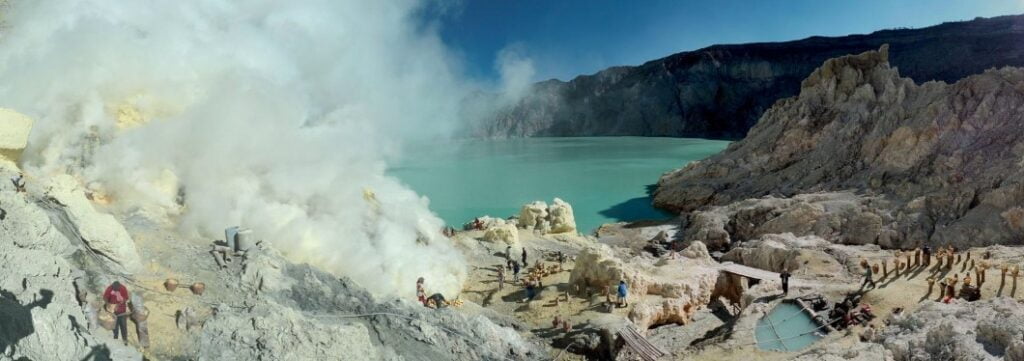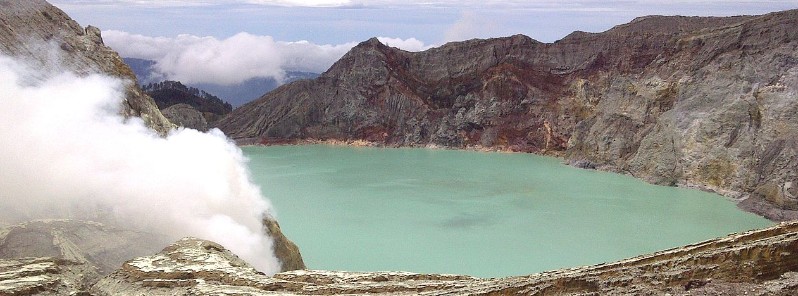The Volcanology and Geological Disaster Mitigation Center (PVMBG) reported that beginning in July 2022, the seismic network at Ijen volcano in East Java, Indonesia began detecting increasing numbers of shallow volcanic earthquakes and earthquake signals characteristic of emissions, indicating increasing pressure at shallow depths within the hydrothermal system.
On January 1, 2023, the number of shallow volcanic earthquakes again increased. The temperature of the crater lake water rose from 16 °C (60.8 °F) in December 2022 to 45.6 °C (114 °F) on January 5, 2023.
During a field visit on January 5, scientists noted that the color of the lake water was light green, dense white solfatara plumes were visible rising from vents, and the sulfur odor was strong. Increased activity at the volcano is often characterized by a change in the lake water color from green to whitish-green due to the resuspension of disturbed lake-bottom sediments from increased gas emissions.1
The elevated unrest prompted PVMBG to raise the Alert Level to 2 (on a scale of 1-4) on January 7, 2023. Residents, visitors, and miners were advised to not approach the crater within 1.5 km (0.93 miles). Communities living along the Banyu Pait River should be aware of the potential danger of volcanic gas flows and pay close attention to any changes in the volcano’s activity. If there is a strong sulfur odor, it is recommended to use a respirator mask or, in an emergency, a wet cloth to cover the nose and mouth.
It is important to note that Ijen volcano is known for its acidic crater lake and the highly toxic gases it releases. Therefore, it is crucial that PVMBG’s recommendations are followed and that people living in close proximity to the volcano remain vigilant and take necessary precautions.
A reminder of the potential hazards, a volcanic tremor at Ijen triggered the release of poisonous gas and an isolated 3 m (10 feet) high tsunami (seiche) at 05:30 UTC (12:30 LT) on Friday, May 29, 2020, resulting in the death of one sulfur miner.2
The victim was said to be working with another miner when the incident occurred. The latter managed to run and survive, while the former disappeared and was eventually found dead.
In March 2018, 24 people were injured when the volcano released toxic gasses. Authorities said 30 people were exposed to gas and 24 of them were sent to local hospitals.3
One of the locals said that residents living in 3 hamlets close to the crater (Margahayu Hamlet, Watu Capil and Dusun Curah Macan), have been evacuated to Puskemas Kecamaten Ijen.

The volcano is known for its illegal sulfur mining from the crater of the volcano, where it is found in the form of bright yellow deposits. Miners extract the sulfur by breaking off chunks of the mineral, carrying it out of the crater in baskets, and then transporting it to the processing area. The mining is done manually and can be quite dangerous due to the toxic gases emitted by the volcano.
Miners are exposed to high levels of sulfur dioxide and other toxic gases that can cause respiratory problems, eye irritation, and other health issues. Despite these dangers, sulfur mining has been an important source of income for the local population for many years.
Ijen volcano is also a popular tourist destination, and many visitors come to see the sulfur mining operations and the volcano’s famous blue fire, which is caused by the burning of sulfuric gases at night. However, with the recent increase in activity, visitors and miners are advised to stay away from the crater.
It’s important to note that the mining of sulfur at Ijen volcano is illegal and also it is an environmental concern as sulfur mining can cause ecological destruction and erosion. And also the local communities are exposed to health hazards from toxic emissions.
The Indonesian government has been encouraging the closure of the mines and the development of alternative income sources for the local population.
Geological summary
The Ijen volcano complex at the eastern end of Java consists of a group of small stratovolcanoes constructed within the large 20 km (12.4 miles) wide Ijen (Kendeng) caldera.
The north caldera wall forms a prominent arcuate ridge, but elsewhere the caldera rim is buried by post-caldera volcanoes, including Gunung Merapi, which forms the high point of the complex. Immediately west of the Gunung Merapi stratovolcano is the historically active Kawah Ijen crater, which contains a nearly 1 km (0.62 miles) wide, turquoise-colored, acid lake.
Picturesque Kawah Ijen is the world’s largest highly acidic lake and is the site of a labor-intensive sulfur mining operation in which sulfur-laden baskets are hand-carried from the crater floor. Many other post-caldera cones and craters are located within the caldera or along its rim.
The largest concentration of cones forms an E-W zone across the southern side of the caldera. Coffee plantations cover much of the caldera floor, and tourists are drawn to its waterfalls, hot springs, and volcanic scenery.4
1 Global Volcanism Program, 2023. Report on Ijen (Indonesia). In: Sennert, S K (ed.), Weekly Volcanic Activity Report, 4 January-10 January 2023. Smithsonian Institution and US Geological Survey.
2 Earthquake at Ijen volcano triggers a 3-meter tsunami, killing 1, Indonesia – The Watchers – June 2, 2020
3 Toxic gases released from Kawah Ijen injure 24 people, evacuations ordered – The Watchers – March 22, 2018
4 Ijen – Geological summary – GVP




